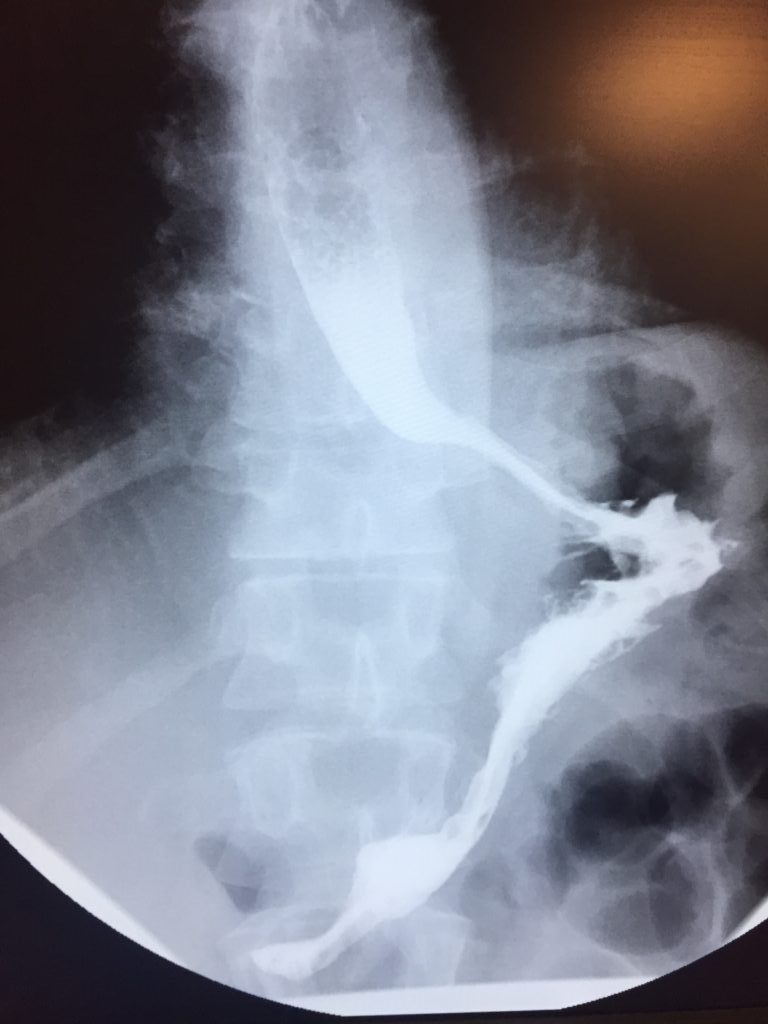In his seminal paper, “A Stomach Road or Magenstrasse for Gastric Emptying”, James Brasseur concludes that the coordination of contractile waves between gastric fundus and antrum determines the magnitude of the Magenstrasse. Surgical manipulation of gastric fundus in the form of Nissen fundoplication alters gastric fundus wall geometry, compliance, and contractions. As a result, Nissen fundoplication may change the Magenstrasse emptying pathway. Indeed, post-Nissen fundoplication contrast studies demonstrate rapid contrast emptying along the lesser curvature into the duodenum (see above picture). Several studies have demonstrated accelerated gastric emptying following Nissen fundoplication. Some patients, especially children, experience dumping. Post-prandial dumping following Nissen fundoplication in children has been associated with increased levels of GLP-1. GLP-1 secretion is closely associated with food particle emptying along the Magenstrasse.
Reinforcement of the Magenstrasse emptying pathway may be an unintended consequence of wrapping the gastric fundus around the distal esophagus. It may also be one of the main anti-reflux mechanisms created by Nissen fundoplication. Indeed, abnormal gastric emptying and gastric fundus relaxation result in GERD. In other words, a dysfunctional Magenstrasse may be contributing to, if not the root cause, for GERD. Nissen fundoplication cures GERD by restoring the Magenstrasse emptying pathway.
Using Brasseur’s computer simulation model of the stomach, one can numerically calculate intra-gastric fluid motions and study the effect of Nissen fundoplication on the Magenstrasse emptying pathway. The same model can evaluate the effect of antrum preserving longitudinal greater curvature gastric resection. This is a procedure I developed to treat gastroparesis. I suspect that both gastric fundus wrapping, and resection alter the Magenstrasse emptying pathway to favor acid reflux control and promote gastric emptying.
Gastric motility patterns and emptying are complex and poorly understood. Many diseases like GERD and gastroparesis, that have reached epidemic levels in our society, are partly, if not mostly, the result of gastro-duodenal motility disorders. Understanding the basic physiology and pathophysiology of gastric motility and emptying will help elucidate the etiology of complex problems like GERD and gastroparesis. This is sure way to develop reliable therapies that target the root cause of disease rather than its consequences.
When it comes to GERD treatment, targeting the consequences of gastric motility disorders by reinforcing the lower esophageal sphincter, is associated with poor acid reflux control. Stretta, TIF, and LINX surgery are perfect examples of LES reinforcement techniques that have unacceptably low success and durability rates. Currently, the most reliable treatment for GERD is a properly performed Nissen fundoplication and hiatal hernia repair. At Houston Heartburn and Reflux Center, we guarantee 100% success rate. If you struggle with heartburn, food regurgitation, bloating, excessive burping, cough or hoarseness give us a call at 832-945-8717.

